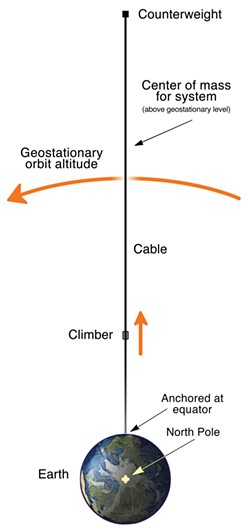[
{
"name": "Top Stories Video Pair",
"insertPoint": "7",
"component": "17087298",
"parentWrapperClass": "fdn-ads-inline-content-block",
"requiredCountToDisplay": "1"
}
]
When a passenger jet takes off, about one-third of its weight is the fuel it will burn flying from point A to point B. Rocket designers would swoon for such efficiency! When NASA blasts a rocket into orbit, it's basically launching fuel, polluting the atmosphere with the exhaust en route. For instance, fuel accounted for about 95 percent of the weight of the Hubble space shuttle at launch, resulting in a rather pitiful payload; 2,000 tons of fully-fueled shuttle was needed to place the 12-ton space telescope into a 400-mile-high Earth orbit.
The efficient and ecological alternative is the space elevator, or "skyhook" to its fans. The concept, shown in the accompanying diagram, is simple: A vertical cable dangles from orbit to a fixed anchor point on the Earth's equator. To get into space, a "climber" carrying the payload would roll itself up the cable. Typical designs call for a speed of about 200 mph in order to arrive in geostationary orbit, 22,000 miles high, five days after leaving the anchor station.
Most communication satellites hang out over the equator in "geostationary" orbits. As the word implies, an object orbiting 22,000 miles high stays at a fixed point over the planet. To an earthbound observer, it appears stationary, so a dish TV antenna, for instance, doesn't have to be moved around; once aimed at a geostationary satellite, it stays aimed. Construction of a space elevator takes advantage of this phenomenon by lowering the cable from a point in geostationary orbit over the equator, while simultaneously spooling out cable in the opposite direction. Eventually the "down" cable, all 22,000 miles of it, hangs vertically, tethered to an anchor station on Earth's surface (a floating barge in an ocean, in most proposals). The cable stays taut due to centrifugal force on a massive counterweight at the other end.
Sounds great, let's go build one! All we need is a (very) long cable strong enough to support its own weight, after allowing for both decreasing gravity the higher you go, and the counterbalancing effect of centrifugal force. In round numbers, the cable has to support 3,000 miles of its own weight. Steel doesn't do it — nowhere near; a 20-mile long steel cable would break under its own weight. Kevlar, fiberglass or carbon-graphite fibers get us up to around 300 miles, still way too weak. What we need is a material with very high specific strength, that is, great tensile strength compared to its mass. Since most of an atom's mass is in its nucleus, we're looking for an element with comparatively few protons and neutrons, but many outer electrons to bond strongly to its neighbors.
Which is why carbon nanotubes are looking promising as space elevator cable material — carbon has an atomic weight of 6, compared to, for instance, 56 for iron. Long nanotubes of carbon arranged in a honeycomb lattice are, weight-for-weight, a thousand times stronger than steel, and might work — in theory. Practically, the longest defect-free carbon nanotubes (and similar graphene ribbons) to date are inches long, not the thousands of miles needed for this venture.
But that's just a matter of time, if past technological hurdles are any gauge. One day — not soon, but perhaps in a century or two — we'll be reaching space by elevator, not by rocket. Only then, I believe, can we really start thinking of ourselves as a spacefaring civilization — without polluting our precious atmosphere as we go.
Barry Evans ([email protected]) thinks that we're in a two-dimensional hiatus of existence on Earth's surface, between the three-dimensionality of the ocean 400 million years behind us and space just ahead.
Comments
Showing 1-1 of 1
more from the author
-
Doubting Shakespeare, Part 2: Problems
- May 2, 2024
-
Doubting Shakespeare, Part 1: Stratfordians vs. anti-Stratfordians
- Apr 25, 2024
-
A Brief History of Dildos
- Apr 11, 2024
- More »
Latest in Field Notes
Readers also liked…
-
Trouble on the Line: The Reality Part 2
- Nov 3, 2022

































